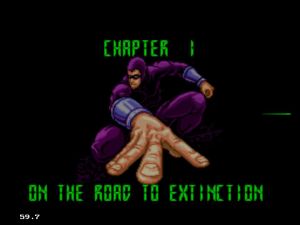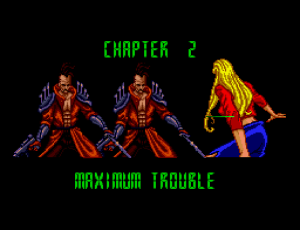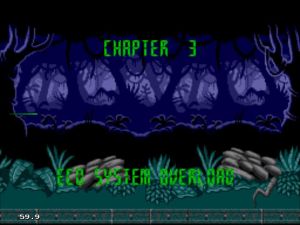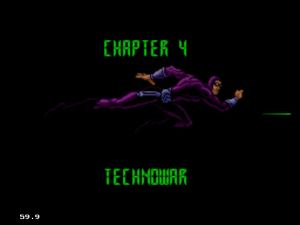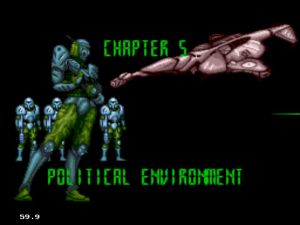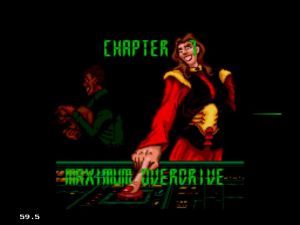Phantom 2040 Walkthrough
Phantom 2040 is a big game, especially for 1994 standards. With several chapters, twelve locations filled with hidden areas, dozens of weapons and branching story paths that mean you’ll never see everything in one playthrough, Phantom 2040 offers many hours of gameplay, but it can also be quite tricky to achieve that elusive perfect ending.
With this walkthrough I’m aiming to provide the most comprehensive guide possible to achieve the perfect outcome in the game, unlocking all possible weapons and revealing all the secrets along the way.
Whether you’ve played the game and completed it before or are exploring it for the first time, I hope this guide will help you on your quest to save Metropia. . . and the world.
Introduction & Notes
Thanks so much for deciding to use this guide. Making a walkthrough guide for Phantom 2040 has been a passion project of mine for several years. I’ve had a few false starts, but I’m hoping that what you see here will be the comprehensive guide to this amazing game!
First Time Players
First time players. . . don’t use this guide.
Yes, I know that sounds counter productive to the whole point of this guide. However, Phantom 2040 is a game that deserves to be played fresh, with no pre-knowledge of what it has in store. Play through the game the way you want to play. Make those all-important decisions for yourself based on what you feel is best and see where they take you. Uncover the games’ secrets on your own. Then, no matter what ending you achieve, come back here and see if you find anything you might have missed.
Truly, Phantom 2040 is a game of choice and consequence and not knowing what is around the corner is half the fun!
Game Variations
There are three versions of the Phantom 2040 game; the Sega Mega Drive/ Genesis release, the Super Nintendo release and the Sega Game Gear release. Of these, the Mega Drive/ Genesis and Super Nintendo versions are almost identical, sharing the same story, level layout and, for the most part, the same items (see notes below for any differences). The Game Gear version, however, is a very different experience although it shares the same basic story line. As such, a guide for that version of the game hasn’t been provided, at least for the moment.
For this guide I will be using the NTSC, or Genesis, release of the game. The reason for this is that for some reason the PAL (Mega Drive) version of 2040 only includes a "summarised" version of the game's story with all cut scenes apart from the opening and ending removed. In the SNES version some of the cutscenes were removed but they remain in the Genesis version.
However, these cutscene changes won’t actually affect what the player will be doing, thus this walkthrough will help you find your way through either the Mega Drive/Genesis releases or SNES version of Phantom 2040.
Mega Drive/ SNES Differences
While the Mega Drive/ Genesis and SNES versions of Phantom 2040 are essentially the same game, there are few subtle differences. Below are brief descriptions of these.
- Graphics - The Sega version of the game runs at a slightly higher resolution. The environments are much more detailed in the Sega version, with with effects such as parallax scrolling. On the SNES, these will just have a flat palette.
- Cut Scenes - Some of the cut scenes were removed for the SNES release, but remain in the Sega version.
- Performance - The game runs a lot more smoothly on Sega's console. Slowdown is much less apparent and the "loading" that occurs before some boss fights and before and after cutscenes on the SNES does not occur.
- Level Difficulty -
- The Ghost Jungle level is a lot easier in the Sega version than in the SNES. Bottomless pits are removed and platforming is easier in the Sega version. Also in the Sega version it is easier to tell which surfaces are destructible as the sprites indicate subtle areas of weakness, as in other levels. This is not apparent in the SNES version and walls must first be shot or punched to be able to tell if they can be broken.
- In the Sega version, there are no enemies hanging from ships during the Air Traffic 2/Prometheus segment, making it somewhat easier.
- Your first visit to Maximum Inc. is much also harder on the SNES.
- Enemies -
- There are areas of the SNES version where more enemies tend to appear than in the Sega version.
- Bosses tend to have an explosion animation showing that you've hit their weak spot in the Sega version, whereas on SNES they'll either blink/flash or have both.
- Sword-carrying enemies don't always block your attacks in the Sega version.
- In the Museum mission, you fight the gang leader atop the tyrannosaurus skeleton in the SNES version of the game, but under it in the Sega release.
- Some enemies seen in the SNES version do not appear in the Mega Drive version.
- The Ghost Jungle boss fights are easier on SNES due to not as many common enemies appearing during the fights.
- The second gang leader you fight is much easier in the SNES release than the Sega one. In the Sega version you also have to contend with sludge which quickly spas your health. On the SNES, the sludge disappears as you reach the gang leader, meaning there are no other obstacles to face.
- Jump Kick - An annoying quirk of the SNES version is that if the Phantom hits his head on a surface above while performing a jump kick, he switches to his falling animation meaning enemies below cannot be harmed. This does not happen in the Sega version.
- BIOT Factory - In the BIOT factory, if you use the Inductance Rope to hang from the moving conveyor belts on the SNES version the game's camera seems to have trouble keeping up with you resulting in the player not being able to see what is ahead. This does not happen in the Sega version.
- Weapons/ Items -
- The Breaker, Homing Missile and Boomerang weapons have a higher rate of fire and movement in the Sega version.
- In the Sega version, you acquire the Fire Retardant Pellets later in the game.
- Your regular gun holds less ammo at the beginning of the game in the Sega version.
- The Energy 1/4 upgrade that causes weapons to use 75% less energy is absent from the Sega version.
- Valves explode once turned in the Mega Drive version, whereas they simply remain in the SNES version.
- In the Sega version of the game, extra lives take the forms of square blue icons that read "1-Up". In the SNES version, they are icons of the Phantom's head.
- Exploding Boxes - Throughout the game you will encounter boxes which will explode after being hit. In the Sega version, the boxes beep and lights on them flash for a few seconds before exploding. This gives you time to get away and can also be used to set up traps for enemies. In the SNES version, however, the lights are always blinking regardless of if the box has been hit or not, and the box explodes on contact.
- Lair Computer - In the SNES the two computer terminals in the middle of the Lair have separate uses - left for the hub map and right for info on places and people. This is totally absent from the Sega version.
- End Game -
- The final boss in the Sega version gets a proper send off. On the SNES, the scene simply fads to black.
- There is no ending track in the Sega version, the boss fight music just continues. The SNES version has a specific track.
Final Notes
Before we get into the guide proper, I just want to re-iterate a few things;
- While I will provide you with as much information as I can, this guide details one possible route through the game. There are many others, and there may be other ways to achieve the good ending, but this is the one I know works. I highly recommend you re-play the game a few times as depending what choices you make some areas will be closed off to you while others will become available. So explore, experiment and have fun.
- In writing this guide I used the NTSC Sega Mega Drive/ Genesis version of the game. If you use the PAL or SNES versions things should be pretty much the same, apart from the differences listed above. Using a different version should not affect the usefulness of this guide.
- It is highly recommend you use a controller with at least six action buttons (that is buttons other than up, down, left, right, start, options). This will make two weapons available to you as well as the Inductance Rope and makes gameplay a lot more enjoyable.
Walkthrough Chapters
I've divided the walkthrough up into the game's seven chapters for ease of accessibility. Click on one of the chapter titles below to get started.
